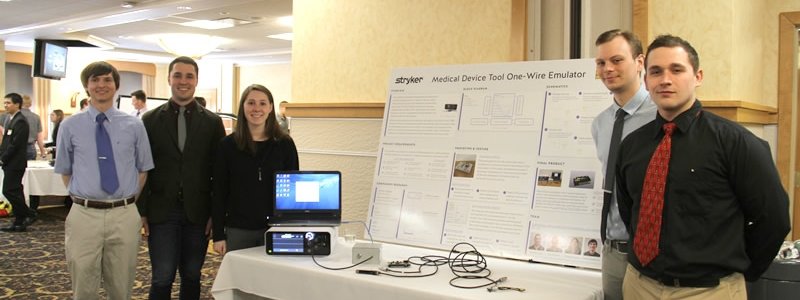Medical Device Tool One-Wire Communication Emulator
Larry Kennedy Industry Innovation Award
Team Members
Charles Lubitz, Morgan English, and Ben Schaedig, Electrical Engineering Technology
Kyle Ludwig and Justin Evankovich, Computer Engineering
Advisors
Trever Hassell and Tony Pinar, Electrical and Computer Engineering
Sponsor
Stryker Instruments
Project Overview
The CORE2 (Consolidated Operating Room Equipment) Console supplies power to a variety
of devices, including small and large bone handpieces, footswitches, and a bone mill.
CORE2 is a non-sterile, reusable device intended for use outside of the sterile environment
during surgeries, which contains a touch screen graphical user interface (GUI) that
allows the user to program a number of customized settings related to the connected
devices and irrigation. The settings and limitations for each compatible device are
contained within each device’s memory (referred to as NOVRAM), which can be read by
the console. It is our team’s goal to develop a testing process by emulating a device
NOVRAM for the CORE2.
Functional Safety Controller for Autonomous Vehicle Prototype
Team Members
Matt DeGroot, Eric Mason, Isobel Alberts, and Leah Peterson, Computer Engineering
Darien Benner, Electrical Engineering
Advisors
Christopher Middlebrook, Electrical and Computer Engineering
Sponsors
Department of Electrical and Computer Engineering, Enterprise Program
Project Overview
The overarching goal of this project is to create a functional safety controller for
the autonomous vehicle used in the GM/SAE Autodrive competition. The scope of the
project has three main parts. The first is the Simulink Stateflow design that evaluates
the conditions of various sensors to determine the proper state for the vehicle (autonomous
control/user control). The second is testing and validation of the design. Since this
is a safety-related project, validation is a very important step. The third is the
deployment of the Stateflow design to an embedded system.
Radar Integration
Team Members
Braden Bennett, Tanay Patel, and Chen Lou, Electrical Engineering; Jacob LaPonse,
Mechanical Engineering; Codie Hjorth, Computer Engineering
Advisor
Dan Fuhrmann, Electrical and Computer Engineering
Sponsors
Department of Electrical and Computer Engineering, Enterprise Program, AutoDrive Challenge
Project Overview
Our team supports the Robotic Systems Enterprise’s AutoDrive Challenge team by investigating
multiple radar integration in an autonomous vehicle platform. The results from this
project will aid the team in developing a strategy for the most ideal radar placement.
After radar placement location has been approved by the Robotic Systems Enterprise
team, we will fully package and integrate the radars into the autonomous vehicle.
Instrument Transformer Signal Conditioner
Team Members
Mitchell Paris and Austin Schank, Computer Engineering; Christopher Churchill, John
Falzon, and Brad Revett, Electrical Engineering
Advisor
Trever Hassell, Electrical and Computer Engineering
Sponsors
Michigan Technological University, Industry Partner
Project Overview
Our team is implementing a device that interacts with current switchgear used in power
transmission, so that it adheres to the IEC 61850-9-2 standard. The device will take
in 8 AC analog signals from a switchgear (4 voltage and 4 current), convert these
signals into a digital representation using analog to digital converters, and send
this information out over Ethernet following the packet outline in IEC 61850-9-2.
Human Machine Interface (HMI) Annunciator Replacement
Team Members
Lucas Kuta, Forestry; Joel Jepson, Seth Majeski, and Jonathan Schulz, Computer Engineering;
Kelsey Stickney, Electrical Engineering
Advisor
Chee-Wooi Ten, Electrical and Computer Engineering
Sponsor
ITC Holdings Corporation
Project Overview
The Annunciator human machine interface (HMI) is the primary interface between technicians
and their electrical substations. Using the Annunciator, operators can monitor the
states of devices from one central location. ITC currently runs Windows XP and bulky
enterprise software on legacy hardware with stringent disk and processing constraints.
ITC requested a software upgrade on a new operating system that would allow for continued
use of the hardware and long-term support. Running on Linux Mint, the new software
operates in three layers: a communications layer to talk between the master station
and outstations; an alarm state layer that saves the status of monitored devices;
and a touchscreen user interface for simple human interaction.
Performance and Protection Characterization of Plug and Play Solar Systems
First Place Design Expo Senior Design Award
Team Members
Lauren Clark, Erik Romanski, Gabe Simmering, and Jason Wesley, Electrical Engineering
Advisor
Sumit Paudyal, Electrical and Computer Engineering
Sponsor
Consumers Energy
Project Overview
Our team researched, tested, and evaluated “Plug and Play” solar systems. These systems
consist of all-in-one packages of solar panels, inverters, and hardware that are advertised
to produce power for homeowners by plugging into any 120V receptacle. We performed
market research to determine overall demand and popularity, worked with standards
and codes to determine the safety and legality of recommended installations, and tested
products to ensure they meet Institute of Electrical and Electronics Engineers (IEEE)
standards. We provided our findings and recommendations for future policies and actions
regarding safe and responsible use to Consumers Energy so they can appropriately plan
for the use of “Plug and Play” systems in their service territory.
Optical Design Camera System
Team Members
Stephen Grulke, Isaac Rasmusson, and Matthew O’Brien, Electrical Engineering; Qiyue
Lin, Computer Engineering
Advisor
Durdu Guney, Electrical and Computer Engineering
Sponsor
Department of Electrical and Computer Engineering, Enterprise Program
Project Overview
Our group is in charge of exploring and documenting optical camera functionality on
autonomous vehicles. This includes providing multiple designs and camera layouts that
are backed up with simulation results. These designs include the device the cameras
are attached to, as well as mounted camera specifications. We are also providing research
into relevant camera characteristics and the reasoning behind our particular camera
choices. Our research and design is intended as a starting point for further exploration
of the topic.
